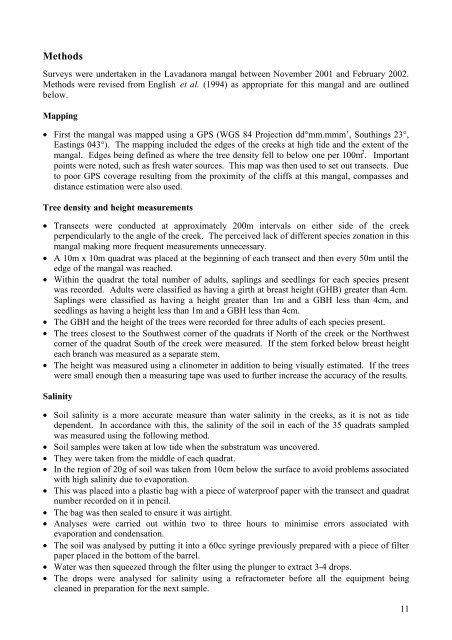Mangrove biodiversity survey south of the Onilahy River - Frontier ...
Mangrove biodiversity survey south of the Onilahy River - Frontier ...
Mangrove biodiversity survey south of the Onilahy River - Frontier ...
You also want an ePaper? Increase the reach of your titles
YUMPU automatically turns print PDFs into web optimized ePapers that Google loves.
Methods<br />
Surveys were undertaken in <strong>the</strong> Lavadanora mangal between November 2001 and February 2002.<br />
Methods were revised from English et al. (1994) as appropriate for this mangal and are outlined<br />
below.<br />
Mapping<br />
• First <strong>the</strong> mangal was mapped using a GPS (WGS 84 Projection dd°mm.mmm’, Southings 23°,<br />
Eastings 043°). The mapping included <strong>the</strong> edges <strong>of</strong> <strong>the</strong> creeks at high tide and <strong>the</strong> extent <strong>of</strong> <strong>the</strong><br />
mangal. Edges being defined as where <strong>the</strong> tree density fell to below one per 100m 2 . Important<br />
points were noted, such as fresh water sources. This map was <strong>the</strong>n used to set out transects. Due<br />
to poor GPS coverage resulting from <strong>the</strong> proximity <strong>of</strong> <strong>the</strong> cliffs at this mangal, compasses and<br />
distance estimation were also used.<br />
Tree density and height measurements<br />
• Transects were conducted at approximately 200m intervals on ei<strong>the</strong>r side <strong>of</strong> <strong>the</strong> creek<br />
perpendicularly to <strong>the</strong> angle <strong>of</strong> <strong>the</strong> creek. The perceived lack <strong>of</strong> different species zonation in this<br />
mangal making more frequent measurements unnecessary.<br />
• A 10m x 10m quadrat was placed at <strong>the</strong> beginning <strong>of</strong> each transect and <strong>the</strong>n every 50m until <strong>the</strong><br />
edge <strong>of</strong> <strong>the</strong> mangal was reached.<br />
• Within <strong>the</strong> quadrat <strong>the</strong> total number <strong>of</strong> adults, saplings and seedlings for each species present<br />
was recorded. Adults were classified as having a girth at breast height (GHB) greater than 4cm.<br />
Saplings were classified as having a height greater than 1m and a GBH less than 4cm, and<br />
seedlings as having a height less than 1m and a GBH less than 4cm.<br />
• The GBH and <strong>the</strong> height <strong>of</strong> <strong>the</strong> trees were recorded for three adults <strong>of</strong> each species present.<br />
• The trees closest to <strong>the</strong> Southwest corner <strong>of</strong> <strong>the</strong> quadrats if North <strong>of</strong> <strong>the</strong> creek or <strong>the</strong> Northwest<br />
corner <strong>of</strong> <strong>the</strong> quadrat South <strong>of</strong> <strong>the</strong> creek were measured. If <strong>the</strong> stem forked below breast height<br />
each branch was measured as a separate stem.<br />
• The height was measured using a clinometer in addition to being visually estimated. If <strong>the</strong> trees<br />
were small enough <strong>the</strong>n a measuring tape was used to fur<strong>the</strong>r increase <strong>the</strong> accuracy <strong>of</strong> <strong>the</strong> results.<br />
Salinity<br />
• Soil salinity is a more accurate measure than water salinity in <strong>the</strong> creeks, as it is not as tide<br />
dependent. In accordance with this, <strong>the</strong> salinity <strong>of</strong> <strong>the</strong> soil in each <strong>of</strong> <strong>the</strong> 35 quadrats sampled<br />
was measured using <strong>the</strong> following method.<br />
• Soil samples were taken at low tide when <strong>the</strong> substratum was uncovered.<br />
• They were taken from <strong>the</strong> middle <strong>of</strong> each quadrat.<br />
• In <strong>the</strong> region <strong>of</strong> 20g <strong>of</strong> soil was taken from 10cm below <strong>the</strong> surface to avoid problems associated<br />
with high salinity due to evaporation.<br />
• This was placed into a plastic bag with a piece <strong>of</strong> waterpro<strong>of</strong> paper with <strong>the</strong> transect and quadrat<br />
number recorded on it in pencil.<br />
• The bag was <strong>the</strong>n sealed to ensure it was airtight.<br />
• Analyses were carried out within two to three hours to minimise errors associated with<br />
evaporation and condensation.<br />
• The soil was analysed by putting it into a 60cc syringe previously prepared with a piece <strong>of</strong> filter<br />
paper placed in <strong>the</strong> bottom <strong>of</strong> <strong>the</strong> barrel.<br />
• Water was <strong>the</strong>n squeezed through <strong>the</strong> filter using <strong>the</strong> plunger to extract 3-4 drops.<br />
• The drops were analysed for salinity using a refractometer before all <strong>the</strong> equipment being<br />
cleaned in preparation for <strong>the</strong> next sample.<br />
11

















